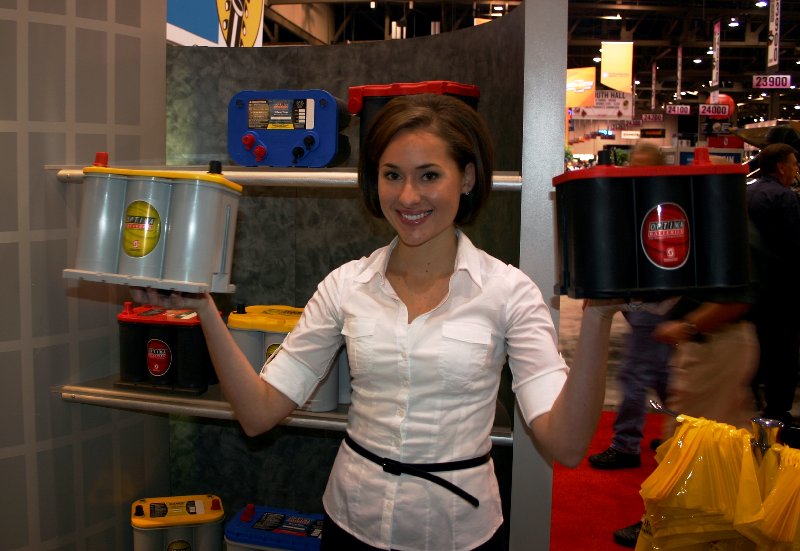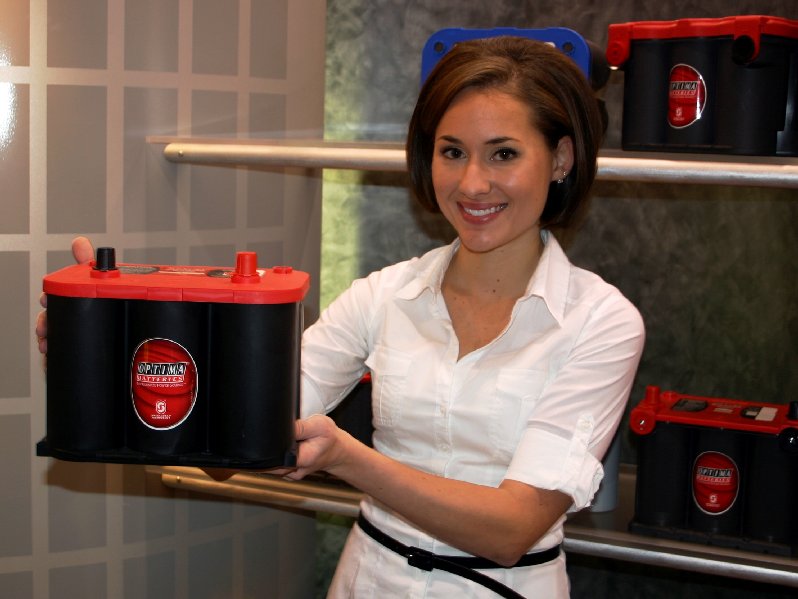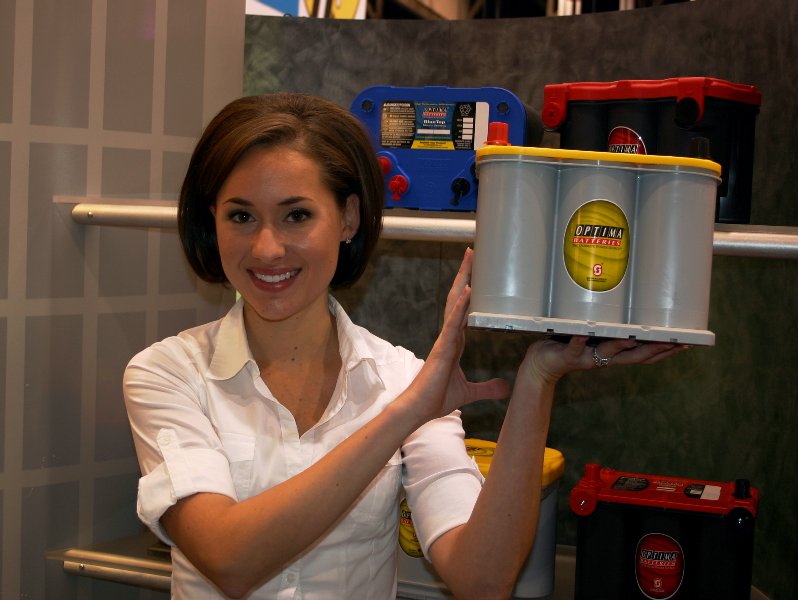Optima Battery: Red or Yellow Top?
Optima Red or Yellow top? I bet you’ve got it wrong!
If you missed the other stories about SEMA, then you didn’t read how Optima Batteries brought up car and truck enthusiasts for a “round table” of sorts to find out what’s happening with their customers. Great idea, right? MyRideisMe.com, through Grease Girl and me, Pikesan, represented the hot rod and custom car crowd. Also strongly represented was the off-road, diesel towing/performance, drag racing and serious computer-audiofile segments.
Why’d Optima do it? Cause they’re serious about making batteries for enthusiasts. The showed me they care about their existing customers and want to earn more by selling a great product.
On the first day, I learned about the “Optima Paradox.” Red top or yellow top? Ken, my expert technical guide, schooled me on how folks that need a yellow top see that it’s more expensive and buy a red top instead. Understandable, but wrong. Optima’s a premium product and costs more than a run of the mill wet battery. But, experience tells you, or should, that getting the right parts for your ride, even if they’re a little more money, always pays off in the end.
Breaking down what I learned, I expect some genuine disbelief, bordering on hate, in the way of comments from this story. Why? Because I’ve already found that some of my buddies are breaking these simple rules:
Red top is for starting.
- High voltage, short duration “bursts” of power when cranking the motor
- Put another way: Big-time cranking amps with only a little discharge because the motors starts and the alternator quickly takes over
Yellow top is dual purpose.
- Purpose #1: Starting, like the red top
- Purpose #2: Continuous or long periods of high demand, high power usage
- Put another way: Crank it, over power your alternator, drain it, then let your charging system catch up. Repeat. This up-down, repeated cycling is what yellow tops are made for.
That’s the basics, let me add some other general rules (here’s where the wrench throwing starts)
- If you think you need more than one battery, get yellow tops
- If you use a “battery tender” or external charging source to keep your ride ready to roll, you need a yellow top
- There’s no reason to have two red tops
- If you’re not sure which one you need, you can’t go wrong with yellow top
- Mixing red tops and yellow tops is wrong! (unless they’re wired completely separately)
Finally, the most general rule:
If you’re running anything on your ride that needs power, especially when the engine is off, that wasn’t there when it was built, you need a yellow top. For example:
- Air compressors for air bags, air horns or whatever
- Stereos with big amps or multiple “Pimp My Ride” style 20 inch LCD monitors in the trunk
- Winch or off-road lighting (or gasp, underbody neon like my PT Cruiser buddies)
- Games systems, DVD players or some alarms
So was I right? Are you doing it wrong? I’m not the expert here, Optima is! If you disagree, I’ll take your comments directly to them.











I’m curious as to what the weight differences for equivalent cold-cranking batteries would be when comparing red-top to yellow-tops. I’ve heard a lot of good things about the weight savings of Optima batteries in general, but I haven’t heard a lot of discussion about the differences between them.
It sounds like yellow tops have the capacity to be more efficient, and will drain engine power less consistently than red tops. Do they only recharge after the battery has been discharged, or is it in a constant recharge state, always pulling from the alternator?
I already heard from the Optima Guys…
The weight difference from red to yellow differs from group size to group size. If you look at a group 34 for instance, the red top weighs in at about 38 pounds, the yellow top weighs in at about 43 pounds. Typically a deep cycle battery would weigh more than a starting battery if the 2 are of similar ratings (CCA/RC). One of the characteristics of a deep cycle battery is thicker grids and heavier paste. In an Optima battery the same holds true.
In a typical charging system the battery is always being somewhat charged while the alternator is also powering other electrical needs. If you have a lot of electrical needs on your car you may be placing to high a demand on the electrical system and eventually a regular (not deep cycle) battery might go dead. Extra demand on the system and charge/discharge cycling requires a battery that can handle it.
One example of why the charge is always happening is to think of the battery as your checkbook, starting the car like writing a check and charging the battery like making a deposit back to your bank account. If the battery demands exceed the vehicle’s ability to “deposit more power” you will eventually be overdrawn! If you then look at the extra stuff on the car and add them as “check writers” you’ll need more money in your account.
So what’s up with the blue top? Marine Battery?
How much for the girl? :-)
” … So what’s up with the blue top? Marine Battery? …”
Yes, all Marine applications should use the Blue Top, which is a combo (start/deep discharge) type like the Yellow Top, but also incorporates the Marine terminals (stud with wing nut) as well as the SAE type (automotive posts). It is the only Optima with Marine terminals.
The easiest way to choose the correct unit is to remember that Optima batteries with grey cases are combination start/deep discharge while those with black cases are start only.
All marine applications require deep discharge capability due to the usual accessories such as radios, trolling motors, sonars, etc fitted in boats. So, for Marine applications you would choose Blue Top with Grey case, which gives you Marine terminals plus deep discharge ability.
You could use a Yellow top for Marine use because functionally it’s similar to Blue Top, but you would usually have to modify the cables to accept SAE terminals. The Blue, similarly, would work in automotive applications because it has both Marine and SAE terminals, but you would need to take care you don’t have any issues with terminals shorting against metal in installation.
Jesse, recharging of a battery is controled by the voltage regulator. A battery has no say when its charged or not, just happens when it gets below x amount of volts.
Wow she is holding those batteries like they weigh 5 pounds. Are those display batteries or something O_o
Busted! Becky’s a strong girl, but not that strong!
I’m not sure which red one to purchase, How do you know which one?
Court,
Once you choose red top or yellow top, sounds like you’ll get the red top, then all you have to do is get one that fits. There’s a few sizes to choose from, with either 720-1000 cold cranking amps (CCA) depending on the temperature. The details, including the sizes are here: Optima Red Top Specs
I have a blue top in a boat use the boat 5 times a year
When not in use i have a tender on it
The battery lasted 2.5 years is there anything i can do to make it last longer
Dan, please send an e-mail to moc.liamgnull@mijamitpo with details about your boat, tender and the circumstances surrounding your previous battery’s demise.
Optima Jim’s a good guy and here to help. Make sure to send him a note.
I am really thinking I will need a YellowTop for my car as eventually I will have a nice sound system in it but my boyfriend wants me to get a RedTop cuz “YellowTops” apparently have problems…. could he be right, is there a reason people have trouble with them even from improper use ie shorting them when installing or anything like that… I’d really like a yellow but I need a good stand for my debate lol
Great post buddy! Informative, entertaining and funny! Awesome.
I have a yellow top that I am about to replace (get this) It spent 7years on my solar power battery bank, A year or so in my truck, than back to the solar power battery bank for about a year .Now its on my camper and still works for the most part. It has just lost a good bit of its capacity but still holds a charge…